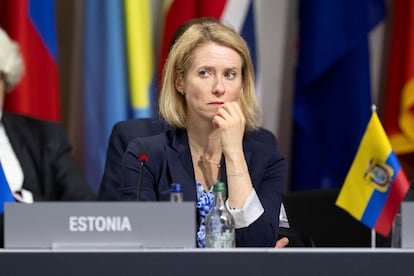Estonia shields itself from the Russian threat: ‘We could hold out for a couple of weeks until the allies arrive’
The Baltic country, one of the EU’s staunchest opponents of the Kremlin, is strengthening its military capabilities, while NATO increases its presence in the region

In the small town of Voru, in the southeast of Estonia, militarization — occurring at a rapid pace — is evident. The locals have become accustomed to the presence of British, French and U.S. soldiers in its bars, or military trucks driving down its cobblestone streets.
The enemy — Russia — is only 18 miles away. And the fear of a possible invasion — which the Estonian authorities don’t rule out at all — is increasingly palpable among the population. Evidence of this is that many of the 12,000 inhabitants of Voru have a full tank of fuel in their cars and a suitcase with the essentials at the ready, in case they have to flee at a moment’s notice.
Very close by, at the Taara Army Base, Colonel Mati Tikerpuu — commander of one of the two brigades of the Baltic country’s army — highlights that, in the event of an enemy incursion, his intention would be to “deal with the invaders as soon as possible.”
The colonel speaks with EL PAÍS in the Officers’ Club. On his uniform, he wears two patches: one with the Estonian flag, the other with the Ukrainian. In addition to being the headquarters of the infantry brigade led by Tikerpuu, the Taara base has a recruit training center (military service is mandatory for men in Estonia) and hosts rotating troops from the United Kingdom, the United States and France: the three nuclear powers of NATO.
Russia’s war in Ukraine — particularly the massacre of civilians — has resurrected the traumas of Stalinism, along with fears of the Kremlin’s expansionism in Estonia, Latvia and Lithuania, the only three former Soviet republics integrated into the EU and the Atlantic Alliance. It’s in this area of the continent where NATO’s credibility is most threatened. In the first months of the large-scale invasion of Ukraine — launched in February 2022 — the Russian army occupied 46,000 square miles, almost triple the size of Estonia, which has an area comparable to Switzerland, the Netherlands, or Denmark.
The vulnerable situation of the Baltic republics — three allies that are especially threatened by Russia, all of them lacking strategic depth and sizable armies — has forced NATO to reconfigure its defense strategy for the region over the last 24 months. Under the provisions in force since 2022, in the event of an invasion, enemy troops would occupy part of the territory before being repelled by a multinational force, in an operation that could last several months. At last year’s NATO summit in Vilnius, Lithuania, new plans were adopted to “defend every inch” of Estonia, Latvia and Lithuania, while increasing the presence of NATO troops in the region.
“We would be able to resist an invasion for a couple of weeks,” Tikerpuu estimates, “long enough until allied reinforcements arrive.” During a trip organized by the Estonian Ministry of Defense, the colonel tells EL PAÍS that a large part of the 19,000 Russian soldiers who were posted just a few miles from Estonia in 2022 are now in Ukraine, or dead. Even so, Estonia’s intelligence services stated in a recent report that Moscow plans to increase its troop presence near the border to almost 40,000 in the coming years.
Estonia has only 4,500 professional soldiers, along with 90,000 reservists. Despite having raised defense spending above 3.5% of GDP (one of the highest percentages among NATO members), its army doesn’t have a single tank, much less a combat aircraft. And its entire population of only 1.3 million inhabitants is comparable to the number of soldiers in the Russian Armed Forces (according to official figures).
“Shadow War”
The relationship between Tallinn and Moscow has deteriorated deeply over the last decade. In September 2014, coinciding with the NATO summit in Wales — during which leaders discussed plans to protect Eastern European allies after the illegal annexation of the Ukrainian peninsula of Crimea — an Estonian police officer was kidnapped at the border by agents from Russia’s Federal Security Service. Ultimately, he was exchanged for a Kremlin spy. But since then, the Estonian authorities have denounced countless “hybrid warfare attacks.” These include sabotage to underwater cables, interference with the GPS signals disinformation campaigns and cyberattacks originating from Russia.
Kaja Kallas — the Estonian prime minister — insists that Russia is waging a “shadow war” against the West. The liberal politician — who aspires to succeed Spanish politician Josep Borrell as high representative for EU Foreign Affairs and Security Policy — has emerged as one of the main hawks in Brussels, where she urges the approval of even tougher sanctions against Moscow. Kallas — who is accustomed to being labeled a warmonger for demanding the rearmament of Europe and the sending of much more military aid to Ukraine — was placed on a “wanted” list by the Russian authorities in February.

In Luhamaa — one of the four border posts between EU community territory and Russia that remain open — dozens of truck drivers and a few families in private vehicles suffer the consequences of the tension between Estonia and its gigantic neighbor. They try to be patient while the customs line remains motionless. Vehicles cross in trickles: some wait there for many hours, while others have to spend several days idling until their turn comes. Estonian agents carefully inspect the merchandise of each truck, almost all of which are registered in Serbia or Central Asian countries (Russia doesn’t allow the circulation of long-haul vehicles with European plates). On a good day, when there aren’t too many obstacles from the other side, about 60 vehicles cross. “The Russians stopped answering our phone calls in April 2022,” says Peter Maran, head of the border guard.
Around Luhamaa, Estonia is erecting a robust border fence that will be equipped with cameras, sensors and radar. In addition to the construction of the wall (which is set to be completed next year), the government is planning a network of 600 bunkers to be built along the 182 miles that separate the country from Russia. At the end of May, three Baltic countries — along with Norway, Finland and Poland — agreed to create a coordinated drone system along their eastern borders. A couple of days earlier, in the north, Russian border guards removed 25 buoys marking the boundary along the Narva River from Estonian waters.
In addition to doubling military spending, Estonia is one of the allies that has donated the most aid to Ukraine (1.7% of its GDP). In the Estonian Ministry of Defense, most officials feel that countries such as Germany, Italy and Spain must make a greater effort to prevent the Kremlin from achieving its objectives in Ukraine.
Different Western intelligence services agree on the possibility of Russia attacking a NATO member between the next five and 10 years. They don’t contemplate the option of an entire country being invaded, but rather a ground operation in which a strip of land is occupied to test the principle of collective defense, the cornerstone of the transatlantic organization.
Lieutenant-Colonel Meelis Vilippus — head of the International Cooperation Section of the Estonian Defense Forces — believes that Russia will maintain “the imperialist attitude that it has never renounced since the 17th century” if it’s not defeated in Ukraine. “They could attack us in two or three years,” Vilippus predicts.
Sign up for our weekly newsletter to get more English-language news coverage from EL PAÍS USA Edition
Tu suscripción se está usando en otro dispositivo
¿Quieres añadir otro usuario a tu suscripción?
Si continúas leyendo en este dispositivo, no se podrá leer en el otro.
FlechaTu suscripción se está usando en otro dispositivo y solo puedes acceder a EL PAÍS desde un dispositivo a la vez.
Si quieres compartir tu cuenta, cambia tu suscripción a la modalidad Premium, así podrás añadir otro usuario. Cada uno accederá con su propia cuenta de email, lo que os permitirá personalizar vuestra experiencia en EL PAÍS.
¿Tienes una suscripción de empresa? Accede aquí para contratar más cuentas.
En el caso de no saber quién está usando tu cuenta, te recomendamos cambiar tu contraseña aquí.
Si decides continuar compartiendo tu cuenta, este mensaje se mostrará en tu dispositivo y en el de la otra persona que está usando tu cuenta de forma indefinida, afectando a tu experiencia de lectura. Puedes consultar aquí los términos y condiciones de la suscripción digital.
More information
Archived In
Últimas noticias
Most viewed
- Sinaloa Cartel war is taking its toll on Los Chapitos
- Oona Chaplin: ‘I told James Cameron that I was living in a treehouse and starting a permaculture project with a friend’
- Reinhard Genzel, Nobel laureate in physics: ‘One-minute videos will never give you the truth’
- Why the price of coffee has skyrocketed: from Brazilian plantations to specialty coffee houses
- Silver prices are going crazy: This is what’s fueling the rally










































